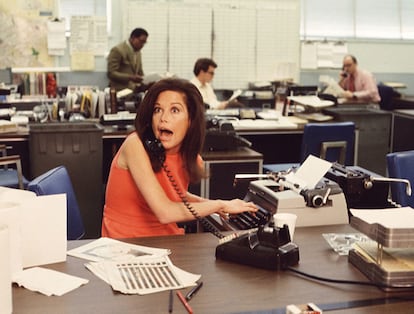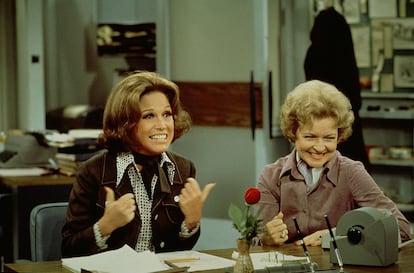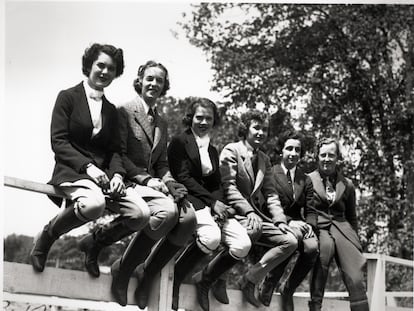Mary Tyler Moore: the actress who stood up to ‘incorrigible alpha males’ in the 1970s
The comedian’s show had a massive impact on the television industry, on pop culture and, above all, on the portrayal of women on screen

At the beginning of the 21st century, American television was dominated by “a bunch of incorrigible alpha males,” as described by television analyst Joy Press. If that was the case in the early-2000s, imagine what things were like in the same universe back in 1970 – the year that The Mary Tyler Moore Show premiered on CBS. It starred Mary Tyler Moore herself: one of the pioneering comedians on TV, who was also considered to be feminist icon. The series had a massive impact on the television industry, on pop culture and, above all, on the portrayal of women on screen.
HBO recently released a documentary – Being Mary Tyler Moore – about the story of the actress, who marked entire generations of women with her fresh presence. She was a self-confident protagonist who “didn’t stay at home and was contemporary, without fear or resentment,” as noted in the documentary. Many years after her television triumph, the other defining role of her career would come from Robert Redford, who directed her as the mother in Ordinary People (1980) – an overwhelming film that won four Academy Awards. She was nominated for Best Actress, which was ultimately won by Sissy Spacek for her performance in Coal Miner’s Daughter. But Moore did take home the Golden Globe.
The HBO documentary focuses on the important and painful moments in her life. It’s also strung together with clips from her interviews, TV episodes and movies. The narration also touches on the misogyny she had to endure throughout her career, the inappropriate questions she was asked, as well as the ups and downs of her life. Her seven Emmy Awards, three Golden Globes and Oscar nomination are only the surface of her story.
Why was Moore so disruptive? Well, she was the first woman on TV to have her own program. On top of that, she played a single, divorced woman, who had no intention of looking for a husband. Her show was revolutionary and highly celebrated.
Moore – born in 1936, in New York – was the first woman to wear pants on television (her famous Capri) when she was part of The Dick Van Dyke Show, which ran from 1961 until 1966, for which she won an Emmy. She – along with Gloria Steinem and Betty Friedan – was an activist at the height of the feminist movement. On talk shows, she cited works by her fellow feminists. Today, she continues to be cited as an inspiration by directors, screenwriters and actresses across Hollywood. Reese Witherspoon, for instance – the star and producer of dominant series such as Big Little Lies and The Morning Show – has noted that women like Mary Tyler Moore “marked the path that I’m following today.”
Many women remember how they grew up in the 1970s devouring The Mary Tyler Moore Show. “Back then, I wouldn’t have been able to explain why, but I saw… the impudence and ambition that her character had,” says Press, who recalls that the protagonists were young women who challenged their limits. “Sometimes, it seemed as if they were winking at me – as if acknowledging the absurdity of their situation.”
Mary Tyler Moore was born into an impoverished family with storied roots in the Confederate Army. She always sought the approval of her father, while her alcoholic mother was more comfortable partying than supporting her daughter. “She was the best to have a good time with, but not the most attentive mother. She would [start drinking in the mornings]… I didn’t know anything about alcoholism and I believed that, if she really loved me, she would have stopped,” Moore once confessed.
Mary Tyler was married three times. The first marriage happened in 1954, just after getting out of high school. “I think it was because of the pressure they put on us [girls] in the 50s,” she sighed. Her son, Richard, was born just a year later. Subsequently, she landed the first role she applied for: in a commercial for an appliance store, in which she played a pixie. After that, she was rejected from several jobs, until she was cast in her first major television appearance on The Dick Van Dyke Show. She played Laura Petrie – the protagonist’s spouse – a housewife who was given an original incarnation by Moore. When Laura was shown doing housework, she would be wearing Capri pants, because – as Moore noted – “women don’t vacuum while dressed in long skirts.”
Before Moore, there was Lucille Ball, from I Love Lucy, which aired from 1951 until 1956. In this family-friendly comedy, the post-war atmosphere was conveyed for viewers. Moore – who was a huge fan of Lucille – managed to slip through one of the doors that I Love Lucy opened for her. Shortly after Moore achieved success with her own series, Ball came to visit a rehearsal and told the younger actress: “You’re very good.”
“It was the best gift I’ve ever received,” Moore laughed. A few months later – after she had won an Emmy – Ball invited her to an interview on her talk show, Let’s Talk to Lucy. She told all her viewers that Moore was one of the best talents that she had seen on television in recent years. Two great comedians were united as comrades.
In Being Mary Tyler Moore, the viewers get to see a fascinating version of the actress: extremely stylish, brilliant and forceful in her answers (without being rude, even if the questions were). In one clip, from 1966 – just before she hit ultimate stardom – she is seen on The David Susskind Show, being asked how she can manage two marriages and a career without neglecting “domestic matters.” Without losing her wonderful smile, Moore advised all women to work and be financially independent. “We are human beings – women first, and then wives and mothers.” She also added that she “spends time with her son and doesn’t waste a single moment.” Then, she cited Betty Friedan and her book, The Feminist Mystique.
In her famous dictum, Steinen wrote about what aliens would think of American women, if they suddenly arrived and watched 20 years’ worth of movies and television:
1. Women sleep with makeup on – they wear it at all times
2. Many of us seem to be maids
3. A whole lot of us seem to be sex addicts
4. The rest of us seem to be total prudes
5. The majority of us depend on men – we seem to need a man to have a personality
6. If we live alone, it’s likely because we’re widowed
But this, she added at the end, is changing. By 1975, The Mary Tyler Moore show had been on the air for five years: it had established a Mary who was, simply, living her life. Every self-respecting American wanted to be like her.
All this had been possible because she took hold of the reins. Following The Dick Van Dyke Show, she had faced setbacks in everything she took on, including the musical version of Breakfast at Tiffany’s on Broadway. In just four years, she went from total success to becoming a has-been. But then, with her second husband, Grant Tinker – along with James L. Brooks and Allan Burns – they created and sold a series about her to CBS.
Brooks – who would go on to direct films such as Spanglish and As Good as it Gets – remembers the process they went through: “We took the idea and presented it to 22 executives… [they didn’t want to do it], but we made it happen. We had Mary, who was very mentally adept – nobody understood humor like she did.”
Treva Silverman was hired to write the series. She would become the first female writer to win an Emmy. After some painful early tests, they built a perfect pilot. The show – which opens with Moore throwing her hat in the air – would be on the air for seven years.
There were other series where there were single women… but they were all going to get married. In the documentary, Brooks notes that this set Mary apart. “They were broadcasting us in a bad time slot, because the person in charge at CBS didn’t like the series… but then they put us in a different time slot and we were able to break through,” he continues. The audience was with them almost from the beginning. Accompanying her in the series was Ed Asner, in the role of Lou Grant, as well as the great Betty White, who would later star in The Golden Girls. Together, they executed scripts written by more women than ever, where Moore was the basis of everything.
As the show hired more female writers than any other TV series to date, the language of television changed. It also touched on issues that were unusual for television during those years, including the loneliness of single women, prostitution, unequal wages, marriage and infidelity. Or birth control pills, which are taken by Mary Richards, who is played by Moore.
Following the success of the show, Moore could have continued churning out massively successful TV series. But shortly after filming ended – and after losing her 21-year-old sister to suicide – she divorced Grant after 18 years of marriage and moved back to New York. She decided to move away from the overwhelming success of television to embark on a career in theatre. In one play – Whose Life is it Anyway? – she defended the right to die with dignity. Moore won a Tony Award for her stunning performance.
In New York, the actress later confessed, she lived alone for the first time, at the age of 45. “It was very difficult for me. It was like a kind of adolescence – [I was] single for the first time. I had dates, I went out, I stayed in. I had new friends. It was like playing house.” She felt freer than ever. Her friends, meanwhile, pointed out that her sense of humor fit in better in New York than in Los Angeles.
She didn’t know it then, but four years before her Tony Award, Robert Redford had read Judith Guest’s debut novel, Ordinary People. Before he even bought the rights to the book, he thought of Moore for the role of the mother. He wanted to see “the dark side of [Mary Tyler].” And he gave her the most important and most timely role in her career: that of Beth, an emotionless, traumatized mother, deeply wounded after losing one of her children.
Just a few months after the production was complete, Moore would experience the same thing as the character she had played, when her son, Richard, lost his life at the age of 24. This was due to an accident with a weapon, which has never been fully clarified.

Viewers also adored her for that work. She earned an Oscar nomination “for her role as a mother unwilling to give up her beliefs about the meaning of life and love.” The film – which would turn out to cruelly imitate her life – changed her a lot. In the HBO documentary, the personal turn is very noticeable in the interviews before and after Richard’s death. She is pensive, confused, hurt. “I’m still angry… I haven’t reconciled with what happened,” Tyler says, without the sparkle in her eyes that – up until that point – she had displayed throughout her entire life.
The actress fell in love again, in 1982, with a doctor from New York. He was younger than her – something that she often joked about – and she would spend the rest of her days with him, until her death in 2017. The voice of her husband – who came into her life when she was 47-years-old – can be heard in the documentary. With him, Moore notes, “I was ready to be myself, without a mask, showing my flaws.” It was with his support – as she herself explains in an interview – that she managed to enter the Betty Ford Center (co-founded by former First Lady Betty Ford, President Gerald Ford’s wife) to combat her problems with alcoholism. “Liza Minnelli or Liz Taylor had been there… so I said, why not?” she humorously pointed out.
After checking herself out in 1984, the woman who could “make the world better with her smile” and her beloved husband moved into a quiet house in the countryside. She continued to work in film and television and continued to give interviews. One of them was with Oprah Winfrey, who told her: “You don’t know what you mean to me – some of us only had television as inspiration and you were one of those women who showed us the light.”
Countless other voices in the documentary share a similar sentiment. Actress and producer Julia Louis-Dreyfus – who achieved fame by playing Elaine in Seinfeld – points out that “there will never be a series like that (The Mary Tyler Moore Show) again. Her character, the transition she made from the previous one, was a total feminist statement. It hit me, because I was also surrounded by great female characters.”
With all her appearances, an American designer points out, Mary Tyler Moore “managed to enhance the taste of Americans, just like Jackie Kennedy did. [And] she inspired as many women as Eleanor Roosevelt.”
When asked how much of her was present in the series, Tyler responded: “A lot. My good intentions. My formality. And my belief in happy endings.”
Sign up for our weekly newsletter to get more English-language news coverage from EL PAÍS USA Edition
Tu suscripción se está usando en otro dispositivo
¿Quieres añadir otro usuario a tu suscripción?
Si continúas leyendo en este dispositivo, no se podrá leer en el otro.
FlechaTu suscripción se está usando en otro dispositivo y solo puedes acceder a EL PAÍS desde un dispositivo a la vez.
Si quieres compartir tu cuenta, cambia tu suscripción a la modalidad Premium, así podrás añadir otro usuario. Cada uno accederá con su propia cuenta de email, lo que os permitirá personalizar vuestra experiencia en EL PAÍS.
¿Tienes una suscripción de empresa? Accede aquí para contratar más cuentas.
En el caso de no saber quién está usando tu cuenta, te recomendamos cambiar tu contraseña aquí.
Si decides continuar compartiendo tu cuenta, este mensaje se mostrará en tu dispositivo y en el de la otra persona que está usando tu cuenta de forma indefinida, afectando a tu experiencia de lectura. Puedes consultar aquí los términos y condiciones de la suscripción digital.
More information
Últimas noticias
Most viewed
- Sinaloa Cartel war is taking its toll on Los Chapitos
- Reinhard Genzel, Nobel laureate in physics: ‘One-minute videos will never give you the truth’
- Oona Chaplin: ‘I told James Cameron that I was living in a treehouse and starting a permaculture project with a friend’
- Why the price of coffee has skyrocketed: from Brazilian plantations to specialty coffee houses
- David King, chemist: ‘There are scientists studying how to cool the planet; nobody should stop these experiments from happening’









































